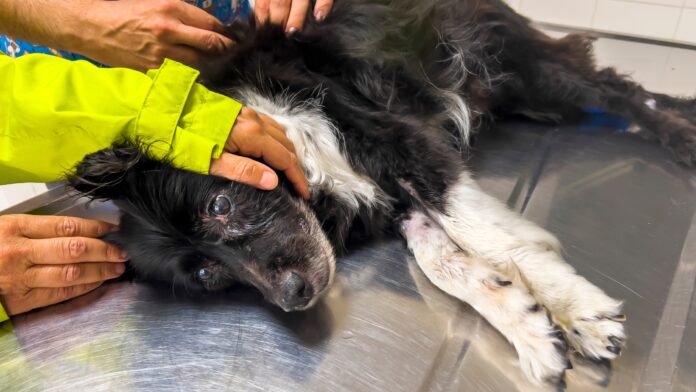As a dog owner, facing the reality that your beloved pet may be nearing the end of their life is incredibly difficult. Recognizing the signs that your dog is dying can help you provide the best possible care during their final days. Understanding these signs can also prepare you emotionally for what lies ahead, allowing you to make informed decisions about your pet’s well-being.
In this comprehensive guide, we will explore the ten signs your dog is dying. From changes in appetite to unusual odors, we’ll cover each symptom in detail. Our goal is to help you navigate this challenging time with empathy and practical advice. Let’s begin this journey of understanding and compassion.
ALSO READ: Effective Dog Weight Loss Tips without Compromising Nutrition
Changes in Appetite and Weight Loss (Ten Signs Your Dog Is Dying)
- Refusal to Eat or Drink: Ten Signs Your Dog Is Dying? One of the earliest signs that a dog is nearing the end of their life is a refusal to eat or drink. This can be due to a variety of factors, including pain, nausea, or a loss of interest in food. You may notice your dog turning away from their favorite meals or showing no interest in treats they once loved. This change can be distressing, but it’s important to understand that it’s a common part of the dying process.
- Noticeable Weight Loss: Along with a decrease in appetite, significant weight loss is often observed. As your dog’s body starts to shut down, they may lose muscle mass and body fat, leading to a gaunt appearance. This weight loss can be quite rapid and is a clear indication that your dog’s health is deteriorating.
- Changes in Food Preferences: Sometimes, dying dogs may exhibit changes in their food preferences. They might suddenly reject dry kibble in favor of wet food or vice versa. They may also develop a preference for softer foods that are easier to chew and digest. Monitoring these changes can help you provide the most comforting food options during this time.
- Impact on Overall Health: These changes in appetite and weight can have a significant impact on your dog’s overall health. Without proper nutrition, your dog may become weak and lethargic, further accelerating the decline in their health. It’s essential to consult with your veterinarian to manage these symptoms and ensure your dog remains as comfortable as possible.
Decreased Mobility and Activity Levels (Ten Signs Your Dog Is Dying)
- Difficulty Moving or Standing: As dogs age and their health declines, they often experience difficulty moving or standing. This can be due to arthritis, muscle weakness, or neurological issues. You may notice your dog struggling to get up from a lying position or having trouble climbing stairs. These signs indicate a decrease in physical capabilities and are common in the final stages of life.
- Reluctance to Engage in Play or Walks: A dog nearing the end of their life will often show reluctance to engage in activities they once enjoyed. Play sessions become shorter or may stop altogether, and walks may be slower and less frequent. This decrease in activity is a clear sign that your dog’s energy levels are waning.
- Increased Sleep and Rest Periods: Dying dogs tend to sleep more as their bodies conserve energy. You might find your dog sleeping for longer periods during the day and night. This increase in rest is a natural part of the process, as their bodies need more time to recover from even minimal exertion.
- Signs of Pain or Discomfort: Watch for signs of pain or discomfort, such as limping, whimpering, or difficulty finding a comfortable position. These signs indicate that your dog may be experiencing significant pain, and it’s crucial to address this with your veterinarian. Pain management can help improve your dog’s quality of life during their final days.
Loss of Bladder and Bowel Control (Ten Signs Your Dog Is Dying)
- Frequent Accidents Indoors: Loss of bladder and bowel control is another sign that a dog is nearing the end of their life. You may notice an increase in accidents indoors, even if your dog was previously well-trained. This can be a source of frustration and sadness, but it’s important to remember that your dog is not doing this intentionally.
- Inability to Control Bladder or Bowels: As your dog’s health declines, they may lose the ability to control their bladder or bowels entirely. This can result in frequent urination or defecation in inappropriate places. These accidents are a sign that your dog’s body is no longer functioning as it should.
- Changes in Bathroom Habits: Changes in bathroom habits, such as increased frequency or difficulty in eliminating, can also be observed. Your dog may struggle to find a suitable spot or take longer to relieve themselves. These changes are indicative of a decline in overall health.
- Potential Underlying Causes: There are several potential underlying causes for the loss of bladder and bowel control, including age-related muscle weakness, neurological issues, or organ failure. Consulting with your veterinarian can help determine the cause and provide appropriate management strategies to keep your dog comfortable.
Changes in Breathing Patterns (Ten Signs Your Dog Is Dying)
- Labored or Shallow Breathing: Changes in breathing patterns are common in dying dogs. You may notice labored or shallow breathing, where your dog appears to be struggling to get enough air. This can be a distressing symptom to observe, but it’s a natural part of the dying process.
- Increased Respiratory Rate: An increased respiratory rate, where your dog breathes faster than usual, is another sign of declining health. This can be a response to pain, anxiety, or underlying respiratory issues. Monitoring your dog’s breathing can provide important clues about their overall condition.
- Wheezing or Coughing: Wheezing or coughing may also occur as your dog’s health deteriorates. These symptoms can indicate respiratory infections, fluid buildup in the lungs, or other serious health issues. It’s essential to seek veterinary advice to manage these symptoms and ensure your dog’s comfort.
- Indicators of Respiratory Distress: Signs of respiratory distress, such as blue-tinged gums, open-mouth breathing, or excessive panting, require immediate veterinary attention. These indicators suggest that your dog is struggling to breathe and may need medical intervention to alleviate their discomfort.
Dull and Sunken Eyes (Ten Signs Your Dog Is Dying)
- Changes in Eye Appearance: As a dog nears the end of their life, their eyes may appear dull and sunken. This change in appearance is often due to dehydration and a general decline in health. The once bright and expressive eyes may lose their luster, indicating a significant health decline.
- Lack of Eye Contact: Dying dogs may also avoid making eye contact. This can be a sign of withdrawal and a lack of interest in their surroundings. The loss of this connection can be heartbreaking for pet owners, but it’s important to understand that it’s a natural part of the dying process.
- Cloudiness or Discharge: Cloudiness or discharge from the eyes can also be observed in dying dogs. These symptoms can indicate infections or other health issues that need to be addressed. Keeping your dog’s eyes clean and monitoring these changes can help manage their comfort.
- What It Signifies About Overall Health: Changes in the eyes are often a reflection of your dog’s overall health. Dull, sunken eyes, coupled with other symptoms, indicate a decline in health and the approach of the end of life. Recognizing these signs can help you provide the necessary care and support.
Behavioral Changes and Withdrawal (Ten Signs Your Dog Is Dying)
- Increased Aggression or Irritability: Behavioral changes, such as increased aggression or irritability, are common in dying dogs. These changes can be a response to pain, confusion, or discomfort. Your dog may growl, snap, or become more easily agitated than usual.
- Withdrawal from Family and Other Pets: Dying dogs often withdraw from family members and other pets. They may seek solitude and spend more time alone. This withdrawal is a natural part of the process, as your dog conserves energy and prepares for the end.
- Lack of Interest in Favorite Activities: A loss of interest in favorite activities, such as playing with toys or going for walks, is another sign of declining health. Your dog may show little enthusiasm for activities they once loved, indicating a lack of energy and overall well-being.
- Changes in Sleeping Patterns: Changes in sleeping patterns, such as increased restlessness at night or excessive sleeping during the day, are also common. These changes reflect your dog’s overall decline in health and the body’s need for more rest and recovery.
Unexplained Bruising and Bleeding (Ten Signs Your Dog Is Dying)
- Signs of Internal Bleeding: Unexplained bruising and bleeding can be signs of internal issues. Internal bleeding may not always be visible but can cause weakness, lethargy, and other symptoms. If you notice these signs, it’s crucial to seek veterinary care immediately.
- Unexplained Bruises on the Body: Bruises that appear without any known cause can be a sign of underlying health problems. These bruises may indicate issues with blood clotting or other serious conditions. Monitoring and reporting these signs to your vet is essential.
- Bleeding from the Nose or Mouth: Bleeding from the nose or mouth is another concerning symptom. This can indicate serious health issues, such as tumors or severe infections. Immediate veterinary attention is necessary to determine the cause and provide appropriate treatment.
- Potential Causes and Implications: Various conditions can cause unexplained bruising and bleeding, including blood disorders, cancer, and severe infections. Understanding these potential causes can help you make informed decisions about your dog’s care and treatment options.
Unusual Odors (Ten Signs Your Dog Is Dying)
- Changes in Breath Odor: Changes in your dog’s breath odor can be a sign of health issues. A sweet or fruity smell can indicate diabetes, while a foul odor may suggest kidney or liver problems. Monitoring these changes can provide valuable insights into your dog’s health.
- Unpleasant Body Smells: Unpleasant body smells can also indicate declining health. These odors may result from infections, poor hygiene, or organ failure. Keeping your dog clean and addressing any underlying health issues can help manage these symptoms.
- Possible Indications of Organ Failure: Unusual odors are often associated with organ failure. For example, a strong ammonia smell can indicate kidney failure, while a musty odor may suggest liver problems. Recognizing these signs can help you seek timely veterinary care.
- Managing and Understanding These Changes: Managing these changes involves regular grooming and monitoring for signs of infection or other health issues. Understanding the underlying causes of unusual odors can help you provide the best care for your dog during their final days.
Persistent Pain and Discomfort (Ten Signs Your Dog Is Dying)
- Signs Your Dog Is in Pain: Recognizing signs of pain in your dog is crucial. Look for changes in behavior, such as whining, limping, or reluctance to move. These signs indicate that your dog may be experiencing significant discomfort.
- Chronic Conditions and Terminal Illness: Chronic conditions, such as arthritis or cancer, can cause persistent pain in dying dogs. Understanding these conditions and their impact on your dog’s quality of life is essential for providing appropriate care and pain management.
- Pain Management and Palliative Care: Pain management and palliative care are critical components of end-of-life care. Working with your veterinarian to develop a pain management plan can help alleviate your dog’s discomfort and improve their quality of life.
- Making End-of-Life Decisions: Making end-of-life decisions, such as considering euthanasia, is one of the most challenging aspects of pet ownership. It’s important to discuss your options with your veterinarian and make a decision that prioritizes your dog’s comfort and well-being.
Conclusion
In summary, recognizing the ten signs your dog is dying can help you provide compassionate and effective care during their final days. From changes in appetite to persistent pain, each sign offers valuable insights into your dog’s health and well-being. It’s important to approach this time with empathy and understanding, ensuring that your dog feels loved and comfortable.
Providing end-of-life care for your dog is a profound responsibility, one that requires emotional strength and practical knowledge. Remember to seek veterinary advice and support, as your veterinarian can guide you through this difficult process. Ultimately, your goal is to ensure that your dog’s final days are filled with love, comfort, and dignity.
FAQs
Q1. How can I make my dog comfortable in their final days?
To make your dog comfortable, provide a quiet and cozy space for them to rest. Offer soft bedding and ensure they have easy access to water and food. Regularly check for signs of pain and consult your vet for appropriate pain management options.
Q2. Should I consider euthanasia for my dying dog?
Euthanasia is a personal decision that should be made in consultation with your veterinarian. If your dog is experiencing unmanageable pain or a significant decline in quality of life, euthanasia may be the kindest option to prevent further suffering.
Q3. How do I know if my dog is in pain?
Signs of pain in dogs include whining, limping, reluctance to move, and changes in behavior. If you notice these signs, consult your veterinarian to develop a pain management plan and ensure your dog’s comfort.
Q4. What are some signs that my dog is ready to pass?
Signs that your dog may be ready to pass include significant weight loss, loss of interest in activities, withdrawal from family, and changes in breathing patterns. These signs indicate a decline in health and the approach of the end of life.
Q5. How can I cope with the loss of my dog?
Coping with the loss of a dog can be challenging. Seek support from friends, family, or pet loss support groups. Allow yourself to grieve and remember the happy moments you shared with your dog. It’s important to take care of your emotional well-being during this time.


